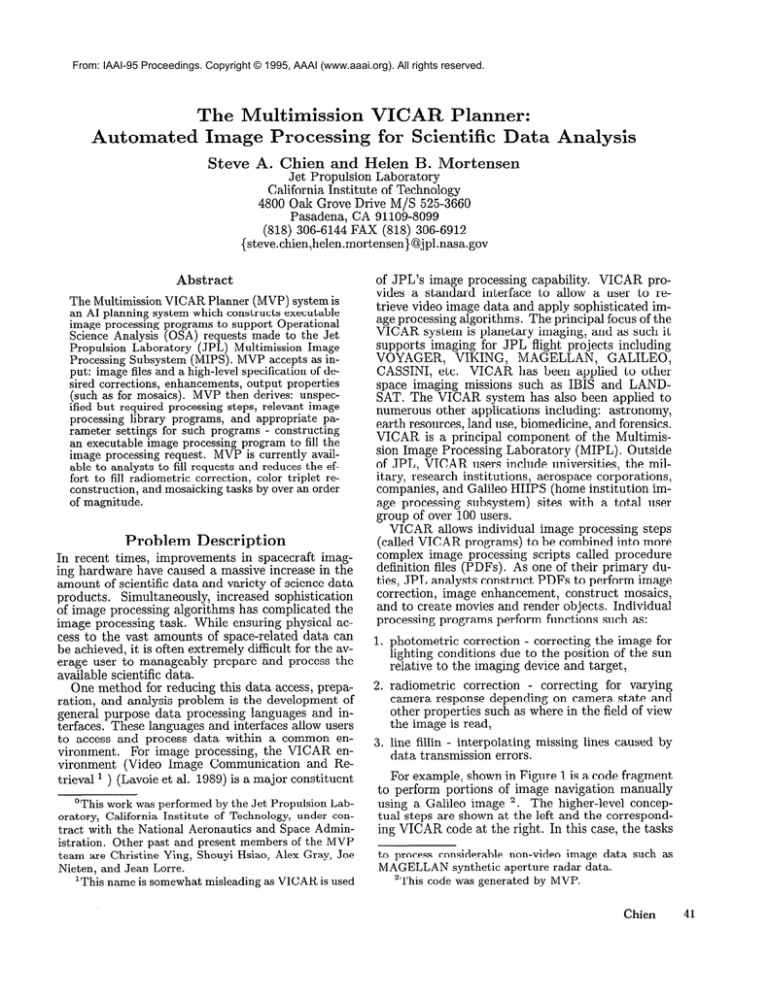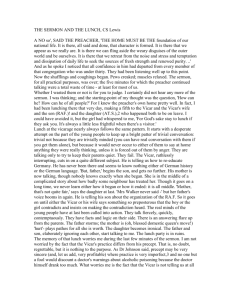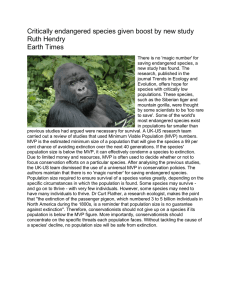The Multimission VICAR Planner: Automated
advertisement

From: IAAI-95 Proceedings. Copyright © 1995, AAAI (www.aaai.org). All rights reserved.
Automated
The Multimission
Image Processing
Steve
A.
Chien
and
VICAR
Planner:
for Scientific
Data
Helen
Analysis
B. Mortensen
Jet Propulsion Laboratory
California Institute of Technology
4800 Oak Grove Drive M/S 525-3660
Pasadena, CA 91109-8099
(818) 306-6144 FAX (818) 306-6912
{steve.chien,helen.mortensen}@jpl.nasa.gov
Abstract
The Multimission
VICAR
Planner
(MVP)
system
is
an AI planning
system
which
constructs
executable
image
processing
programs
to support
Operational
Science
Analysis
(OSA)
requests
made
to the Jet
Propulsion
Laboratory
(JPL)
Multimission
Image
Processing
Subsystem
(MIPS).
MVP
accepts
as input:
image
files and a high-level
specification
of desired
corrections,
enhancements,
output
properties
(such
as for mosaics).
MVP
then derives:
unspecified but required
processing
steps,
relevant
image
processing
library
programs,
and appropriate
parameter
settings
for such programs
- constructing
an executable
image
processing
program
to fill the
image
processing
request.
MVP
is currently
available to analysts
to fill requests
and reduces
the effort
to fill radiometric
correction,
color
triplet
reconstruction,
and mosaicking
tasks
by over an order
of magnitude.
Problem
Description
In recent times, improvements in spacecraft imaging hardware have caused a massive increase in the
amount of scientific data and variety of science data
products. Simultaneously, increased sophistication
of image processing algorithms has complicated the
image processing task. While ensuring physical access to the vast amounts of space-related data can
be achieved, it is often extremely difficult for the average user to manageably prepare and process the
available scientific data.
One method for reducing this data access, preparation, and analysis problem is the development of
general purpose data processing languages and interfaces. These languages and interfaces allow users
to access and process data within a common environment . For image processing, the VICAR environment (Video Image Communication
and Retrieval ’ ) (Lavoie et al. 1989) is a major constituent
‘This
work was p erformed
by the Jet Propulsion
Laboratory,
California
Institute
of Technology,
under
contract
with
the National
Aeronautics
and Space
Administration.
Other
past and present
members
of the MVP
team
are Christine
Ying,
Shouyi
Hsiao,
Alex
Gray,
Joe
Nieten,
and Jean Lorre.
‘This
name is somewhat
misleading
as VICAR
is used
of JPL’s image processing capability. VICAR provides a standard interface to allow a user to retrieve video image data and apply sophisticated image processing algorithms. The principal focus of the
VICAR system is planetary imaging, and as such it
supports imaging for JPL flight projects including
VOYAGER, VIKING,
MAGELLAN,
GALILEO,
CASSINI, etc. VICAR has been applied to other
space imaging missions such as IBIS and LANDSAT. The VICAR system has also been applied to
numerous other applications including: astronomy,
earth resources, land use, biomedicine, and forensics.
VICAR is a principal component of the Multimission Image Processing Laboratory (MIPL). Outside
of JPL, VICAR users include universities, the military, research institutions, aerospace corporations,
companies, and Galileo HIIPS (home institution image processing subsystem) sites with a total user
group of over 100 users.
VICAR allows individual image processing steps
(called VICAR programs) to be combined into more
complex image processing scripts called procedure
definition files (PDFs). As one of their primary duties, JPL analysts construct PDFs to perform image
correction, image enhancement, construct mosaics,
and to create movies and render objects. Individual
processing programs perform functions such as:
1. photometric correction - correcting the image for
lighting conditions due to the position of the sun
relative to the imaging device and target,
2. radiometric correction - correcting for varying
camera response depending on camera state and
other properties such as where in the field of view
the image is read,
3. line fillin - interpolating missing lines caused by
data transmission errors.
For example, shown in Figure 1 is a code fragment
to perform portions of image navigation manually
using a Galileo image 2. The higher-level conceptual steps are shown at the left and the corresponding VICAR code at the right. In this case, the tasks
to process
considerable
non-video
MAGELLAN
synthetic
aperture
2This
code was generated
by
image
data
radar
data.
MVP.
such
Chien
as
41
being accomplished are acquiring initial navigation
information, constructing initial overlap pairs, refining initial overlap pairs, checking for a previous tiepoint file, manually generating or refining tiepoints,
and constructing the OM matrix for image navigation. In this case the overall user goal is to navigate
the image. The other subgoals (and steps) are necessary to support this goal due to the dependencies
of VICAR and image navigation.
In order to fulfill OSA requests for image processing, analysts must create complex VICAR programs, determining relevant programs, order of execution, and parameter settings using their knowledge of the processing steps and processing program
requirements .
Unfortunately,
manual construction of VICAR
programs is both labor and knowledge intensive.
The VICAR procedure generation problem is also
a knowledge intensive task in that an analyst must
possess knowledge of:
1. image processing and image processing programs
(as of l/93 there were approximately 50 frequently
used programs, some having 10s options)
2. database organization and database label information to understand the state of relevant data
3. the VICAR programming
language to produce
and store relevant information.
Because of the complexity and amount of program
knowledge relevant to the task as well as the many
interacting problem goals, VICAR procedure generation is a labor intensive task. Generation of a
complex VICAR procedure may take up to months
of analyst time.
One difficulty facing analysts is the diversity of
knowledge required to produce expert VICAR procedures. While certain VICAR users, such as expert
analysts, may possess much of this knowledge, the
vast majority of VICAR users are novice to one or
more aspects of this knowledge. Unfortunately, this
increases the difficulty of data access and preparation and increases the load on experts who must
spend a significant amount of their time assisting
those less knowledgable. For example, a university
user may know a great deal about the science behind
_ the imaging and the theory behind the processing
steps but may know little about the underlying assumptions of the implementation
of the processing
steps or VICAR itself. Similarly, a programmer who
writes processing programs may know quite a bit
about their particular program but may experience
difficulty in writing a VICAR procedure to generate
data to test his or her program. This great need
for VICAR knowledge exists because of the significant time it takes to become proficient in multiple
aspects of VICAR. Generally, a VICAR user with l2 years of experience is considered a novice VICAR
user, while it may take 4-5 years to become a VICAR
expert.
Application
Description
MVP (Chien 1994a; Chien 1994c) partially automates generation of image processing procedures
42
IAN-95
from user requests and a knowledge-based model
of an image processing area using Artificial Intelligence (AI) automated planning techniques (Iwasaki
and Friedland 1985; Pemberthy and Weld 1992;
Stefik 1981). In AI planning, a system uses: 1) a
model of actions in a domain; 2) a model of the current state; and 3) a specification of the desired state;
to reason about what actions to take to achieve some
specified goals. In VICAR image processing the actions are VICAR image processing programs, the
current state is the current state of the image files
of interest, and the specification of the desired state
corresponds to the user image processing goals. By
partially automating the filling of basic science image processing requests, image processing request
turnaround time will be reduced, analysts time will
be freed for more complex and challenging science
requests, and analyst workload will be reduced.
The MVP
Architecture
The overall architecture for the MVP system is
shown in Figure 2. The user inputs a problem
specification consisting of processing goals and certain image information using a menu-based graphical user interface. These goals and problem context
are then passed to the decomposition-based
planner. The decomposition-based planner uses image
processing knowledge to classify the overall problem
type which the user has specified in a process called
skeletal planning (Iwasaki and F’riedland 1985). This
classification is then used to decompose the problem
into smaller subproblems in a process called hierurchid planning (Stefik 1981). The subproblems produced by the decomposition process are then solved
in a process called operator-bused planning (Pemberthy and Weld 1992), in which a planner uses a
description of possible actions (in this case image
processing steps) to determine how to achieve subproblem goals as indicated by the problem decomposition The resulting plan segments are then assembled using constraints derived in the decomposition process. The resulting plan is then used to
generate an actual executable VICAR PDF using
conventional code-generation techniques.
MVP uses both decomposition
and operatorbased planning paradigms for two reasons: search
control and user understandability.
Plans in the
MVP domain can be of considerable length (up to
100 steps) and each step (or VICAR program) can
involve reasoning about numerous complex effects
(many operators have tens of effects). Due to the
large search space caused by this complexity, conventional operator-based planning approaches are
not able to tractably construct plans in the VICAR
domain without significant control knowledge. By
using the decomposition planning paradigm, MVP
breaks up the large search space planning problems caused by the complexity of the image processing problems in to multiple smaller problems,
thus reducing the search problems encountered during operator-based planning.
Indeed, the problem
decomposition rules used in MVP can be considered
a very important form of search control knowledge
VICAR Code
Conceotual Stem
get initial navigation
information
construct
initial
overlap pairs
refine initial
overlap pairs
_
IBISNAV OUT=‘file~list.NA\P
PLANET=target-O-10
+
PROJECT=‘GLL
’ SEDR=BRIMSRC
FlLENAME=‘~le~lisl.illst’
-
!! ConsIrvct InlUal overlap pairs MOSPLOT
MOSPLOT Inp4le~list.NAV’
nl=lines-O-6 nssamples-O-6
I mos.overlap is just a holderforthe ovedap plot.
dcl copy pdntronx.plt mos.overiap
&I pdnVnofeed mos.ovedap
_
!! Refine initial overlap p&s edibis
EDIBIS INP=‘fileJlstOVER~
/
find previous
tiepoint file
(if present)
!! Manmatch mosaic file list
!I If there is no existing liepoint RI&....
11Check If a liepoint file exists.
”
I! The followf”g code IS In wlltten VMS
f! LOCAL STR STRING INIT = ”
LET-ONFAIL=
‘CONTINUE’
!! Allow the pdf to continue
!I if a file is not found.
DCL DEASSIGN NAME
DCL DEFINE NAME ‘FSSEARCH(‘flle~lisI.Tp’)
LOCAL STR STRING
TRANSLOG NAME STR
LET-ONFAIL
= ‘RETURN’ I! Set PDF to return on error
I! If an old liepoint file exists...
:;!;
old tpfile is part of input and later overwritten.
MANMATCH INP=~flleJlst.NA\P.‘1ileJist.OVER’,’file~llst.TP~
+
OUT=‘file-IisLTP’
PROJECT=‘GLL
“SEDR FILENAME=‘file~list.lLlST
-
!I OMCORP
OMCDW INP=(‘flleJlsLNAV’.‘fileJist.TP’)
OMCDRZ INP=(‘flleJlsLNAV’.‘fileJist.TP’)
PROJECT=‘GLL
PROJECTrGLL
Figure 1: Sample VICAR
Decomposition
’
IF (STR = “)
MANMATCH lNP=~file~list.NA’?~fileJlsl.OVER~)
+
OUT=‘lile~list.TP’
PROJECT=‘GLL
’ ‘SEDR FILENAME=*fileJist.lLlS~
use manmatch
program to
construct
or
refine tiepoint
file
use tiepoints
to construct
OM matrix
project=‘GLL
assembly constraints
DB
Interface
’ GROUND=OGOOD
‘GROUND&GOOD
Code Fragment
essential to MVPs image processing capability.
MVP also uses decomposition-based planning for
reasons of user understandability.
Even if a purely
operator-based planning approach were able to generate plans to solve the VICAR problems, these
plans would be difficult for MIPL analysts to understand because MIPL analysts do not consider an
entire image processing problem all at once. Typically, analysts begin by classifying the general problem being addressed into one of a general class of
problems, such as mosaicking, color triple processing, etc. They then use this classification and the
problem context to decompose the plan into several
abstract steps, such as local correction, navigation,
registration, touch-ups, etc. Because MVP uses
decomposition-based planning to reduce the original image processing problem, it can easily produce
an annotated trace of how the overall problem was
classified and decomposed, simplifying analyst understanding of the plan generation process.
Skeletal
and
Decompositions
i
Figure 2: MVP System Architecture
Hierarchical
Planning
Using
MVP integrates decomposition and operator based
planning paradigms. MVP first reduces a problem
using decomposition methods, then solves the resulting subproblems using operator planning techniques.
MVP uses knowledge represented as decomposition
rules to perform skeletal and hierarchical planning.
Skeletal
and
Hierarchical
Planning
in MVP
Skeletal planning (Iwasaki and Friedland 1985) is
an approach to planning which casts planning as a
structured classification problem. In skeletal planning, a planner identifies a new problem as one of a
Chien
43
RHS
GR = 1. absolute
navigation
Cl =
null
N =
null
LHS
Gl= navigation
action present
CO= null
C2= the project is VOYAGER
or GALILEO
and
limb present
in all images
Figure 5: Hierarchical
Rule
Refinement
Decomposition
the images), for VOYAGER and GALILEO images,
the navigation step can be performed by absolute
navigation (a process in which each of the images
can be navigated independently).
This decomposition-based
approach to skeletal
and hierarchical planning in MVP has several
strengths. First, the decomposition rules very naturally represent the manner in which the analysts
attack the procedure generation problem. Thus, it
was a relatively straightforward
process to get the
analysts to articulate and accept classification and
decomposition rules for the subareas which we have
implemented thus far. Second, the notes from the
decomposition rules used to decompose the problem
can be used to annotate the resulting PDF to make
the VICAR programs more understandable to the
analysts. Third, relatively few problem decomposition rules are easily able to cover a wide range of
problems and decompose them into much smaller
subproblems.
Operator-based
Planning
in MVP
MVP uses classical operator-based planning techniques to solve subproblems produced by the
decomposition-based
planner.
An operator-based
planner uses:
1. a model of actions M (in this case the model represents the requirements and effects of individual
VICAR steps);
2. a specification of a current state C (this corresponds to the current database state); and
3. a specification of a goal criteria G (this corresponds to user request specification)
to derive:
a sequence of actions A, that when executed in
the current state C, result in a state which satisfies
the goal criteria G. In this case A will correspond to
the VICAR script the user can execute to perform
the image processing task at hand.
In onerator-based olanninn, an action is represented *in terms of its preconditions (those things
required to be true before an action can be executed), and its effects (those things true after an
action is executed). For example, in VICAR image
processing, the program GALSOS is used to radiometrically correct Galileo image files. This would
be represented by a planning action for the GALSOS program, which could be applied to an image
file. This action would have the precondition that
the image file be a Galileo image file. This action
would also have the effect that the image file is radiametrically corrected after GALSOS has been run.
When constructing a plan to achieve a goal Gl,
a planner will consider those actions which have Gl
as an effect. Thus, if the planner wanted to achieve
that a particular image file was radiometrically corrected, it would consider applying the VICAR program GALSOS on the image file. If a planner decides
to add an action Al to a plan to achieve a goal, it
will then have to achieve all of the preconditions of
Al. This process is called subgoalin>. For example,
the VICAR program PTP requires that an image file
be in byte format before PTP can be applied. Thus
if the planner decides that it wants to apply the PTP
program to a file, it then must ensure that the image
file is in byte format. In some cases this will already
be true, in other cases running a programs to change
the file format may be required.
Planning is also complicated by the fact that there
are typically interactions between subparts of the
plan. Thus, actions introduced to achieve goals in
one part of the plan may undo goals achieved in another part of the plan. The process of ensuring that
such interactions do not occur is called protection.
Protection can involve such measures as ensuring
that the goal is no longer needed when it is undone,
or ensuring that the offending action effect does not
in fact refer to the same object as the achieved
goal (by creating a copy of a file, for example).
We have only briefly sketched some of the elements
of operator-based planning, for a more detailed
treatment of operator-based planning algorithms the
reader is referred to (Pemberthy and Weld 1992;
Chapman 1987).
To illustrate the operator-based planning process,
consider the (simplified) image processing operators
shown in Figure 6. This information can be summarized by the information shown below indicating the
relevant programs for achieving the goals of missing line fillin, spike removal, and radiometric correction for Voyager and Galileo images. When constructing a plan to achieve these goals, depending on
the project of the image file (e.g., either Voyager or
Galileo), MVP can determine the correct program
to use because the preconditions enforce the correct
program selection.
fillin missing lines
remove spikes
radiometric corr.
Voyager
Galileo
VGRFILLIN
ADESPIKE
FICOR77
GLLFILLIN
ADESPIKE
GALSOS
However, determining the correct ordering of actions can sometimes be complex. In this case, the
correct order to achieve the goals of line fillin, spike
removal, and radiometric correction is dependent
Chien
45
Qperator
VGRFILLIN
GLLFILLIN
ADESPIKE
FICOR77
GALSOS
Preconditions
VGR image
EDR present
GLL image
VGR image
GLL image
raw pixel values
Effects
missing
(GLL image)
or ((VGR image)
and (raw values))
spike removal
not raw values
radiometric corr.
blemish removal
radiometric corr.
reed-solomon
overflow corr.
saturated pixel corr.
not missing line fillin
lines filled in.....
not raw values
Figure 6: Simplified Operator Definitions
upon the project of the file. In the case of Voyager
files, ADESPIKE (spike removal) requires raw pixel
values and FICOR77 (radiometric) changes pixel
values to correct for camera response function, so
FICOR77 removes a necessary condition for ADESPIKE. This interaction can be avoided by enforcing that ADESPIKE occurs before FICOR77. VGRFILLIN requires binary EDR header on the image
file which is not maintained by ADESPIKE, this interaction can be avoided by requiring VGRFILLIN
to be executed before ADESPIKE.
The Galileo case is slightly different. GALSOS undoes missing line fillin so that it interferes with GLLFILLIN. This interaction can be avoided by enforcing GLLFILLIN
after GALSOS. Additionally, GALSOS requires raw pixel values, and ADESPIKE alters the pixel values, so ADESPIKE interferes with
this condition. This interaction can be avoided by
requiring that GALSOS occur before ADESPIKE.
Execution
Order:
Voyager
VGRFILLIN
ADESPIKE
FICOR77
Galileo
GALSOS
GLLFILLIN
ADESPIKE
This simple example illustrates the types of interactions and context-sensitivity
that the VICAR
image processing application entails. All of these
interactions and context sensitive requirements are
derived and accounted for automatically by MVP
using the operator specification, thus allowing construction of plans despite complex interactions and
conditions.
MVP also insulates the user from many of the
lower-level intricacies of image processing by automatically achieving subgoals. To illustrate how the
operator-based planning process performs subgoaling, consider the subgoal graph illustrated in Figure
7.3 In this case the user has selected the goal that
the images be navigated using manual methods and
that the archival navigation information for the image should be updated. The decomposition planner
has access to the knowledge that in order to navigate
3The
taken
46
from
VICAR
this
IAAI-95
code previously
example.
shown
in
Figure
1 is
the image, the operational goal is to construct an
OM matrix which defines the transformation
from
(line, sample) in the image to some known frame of
reference (usually the position relative to the target planet center). The planner knows that in order
to compute this matrix it must have a tiepoint file,
the project of the image, and the image files formatted into a mosaic file list. In order to produce
a tiepoint file for the goal specification of manual
navigation, the planner uses the MANMATCH
program. The MANMATCH
program in turn requires
a refined overlap pairs file, the project of the images, the initial predict information,
and again a
mosaic file list. The refined overlap pairs file can
be constructed using the EDIBIS program, but this
requires a crude overlap pairs file based on an initial
predict source. This crude overlap pairs file in turn
requires the default navigation method, and the latitude and longitude of sample image files. The rest of
the graph is generated similarly. This subgoal graph
is generated in response to the particular combination of user goals and the state of the selected image
files.
MVP also uses operator-based
planning techniques to determine correct program option settings.
MVP uses preconditions to represent various program option settings and the situations under which
they will achieve desired effects. Thus, when an action is selected to achieve a goal, the correct program
option settings have also automatically been determined.
Application
Use
and
Payoff
MVP2.0 is implemented in C and runs Sun SparcStations under Unix and Motif and under VMS on
Vaxes. MVP is currently operational and available
for use by analysts at JPL’s Multimission Image
Processing Laboratory (MIPL) for radiometric correction, color triplet reconstruction,
and mosaicking with relative or absolute navigation, registration,
and simple filtering and stretching tasks. For these
tasks MVP reduces effort to generate an initial PDF
for an expert analyst from l/2 a day to 15 minutes
and reduces the effort for a novice analyst from several days to 1 hour. Thus, by using MVP an analyst
achieves over an order of magnitude improvement in
productivity in generating image processing PDFs.
Figure 7: Subgoal Graph for Manual Relative Navigation
Application
Development
Deployment
and
Initial development on the MVP concept began in
August 1992 and a proof of concept demonstration
system MVPO was produced running in LISP on a
SUN sparcstation by late September 1992 for basic correction tasks (radiometric correction, missing
line fillin, despiking data, photometric correction,
blemish removal and reseau removal) for Voyager
project images. This demonstration was invoked using a text-based interface and accessed a dummy
image database rather than accessing the actual image database. The complete effort for the proof of
concept demonstration was approximately 1 workmonth.
This prototype was well received by the analysts,
and work began on a more complete prototype MVP
1.0. This version was also implemented in LISP and
accessed a dummy image database in flatfile format.
The domain theory for MVP 1.0 extended MVPO by
including Galileo project images, and added absolute
navigation of images as well as several simple filtering and stretching options. MVPl.0 used a graphical
user interface running under Openlook/X. MVP 1.0
was copleted by March 1993. MVP 1.0 was further
extended to cover application programs for registration of data and simple mosaicking tasks in version
1.1, which was completed in September 1993. The
complete development effort for MVP 1 .O and 1.1
was approximately 0.9 work-years, which includes
analyst time and MIPLS programming support.
In October 1993, work began on MVP2.0 which
was intended to be an operational system in the
Multimission Image Processing Laboratory (MIPL).
Prom an AI planning standpoint, MVP2.0 would be
very similar to MVP1.l, with the major difference
that it was to be written in C. This included migration of the decomposition planner (to CLIPS) and
integration of Flex and Bison to parse input operator and rule files. The majority of the port was
completed by March 1994, with April and May be-
of Galileo Image Files
ing spent on testing, developing a Motif-based GUI,
and interfacing MVP2.0 to actual VICAR database
access routines. MVP2.0 was installed in MIPL May
1994. During the summer of 1994, MVP2.0 was extensively tested in the operational setting and used
to generate image products. Simultaneously, it was
extended to cover more complex correction tasks involving registration, and relative navigation. Also,
during this period, a number of knowledge base
development tools were produced (Chien 1994b).
The complete development effort for MVP 2.0 from
September 1993 through September 1994 was approximately 2.2 work years.
Current efforts focus on two fronts: 1) expanding the domain coverage to further image processing
tasks ; 2) providing a development environment to
facilitate extension to new image processing tasks ;
and 3) fielding MVP to a University VICAR image
processing site (called Home Institution Image Processing Sites or HIIPS). We are currently working
on extending the domain knowledge represented in
MVP2.0 to cover more complex mosaicking tasks as
well as filtering and stretching tasks. Development
environment enhancements include tools to analyze
operator sets and rule sets to find simple errors (e.g.
typographical errors) that result in domain theories
where no actions can achieve a goal. Towards fielding MVP at a HIIPS site, we are currently in contact
with personnel from the department of Geology at
Arizona State University about a collaborative effort
to field MVP for Galileo and Magellan science image
processing.
Maintenance
Initial development of the planning knowledge base
was performed by LISP programmer AI personnel
with significant background in AI planning systems
(Versions 1.0 and 1.1). The domain theories for Version 2.0 was developed by a software engineer with
little AI background. The current domain theory is
being used to describe to analysts the overall proChien
47
cess of constructing planning decomposition rules
and operators, with the intention that further versions of the domain theory will be developed by analysts or other VICAR users. Towards support of this
goal, we have been developing a planning knowledge
base debugging environment, which provides static
analyses of the planning knowledge base to perform
simple checks for achievability of goals and runtime
tools to isolate failing preconditions (Chien 1994b).
In current plans, maintenance and extension of the
planner and development environment will be supported by AI group personnel for the near future
(e.g., l-2 years) with the intention that maintenance
and extension of MVP will eventually be taken over
by the Image Processing Section, with the AI group
providing continuing support in a consulting role.
Conclusions
This paper has described the application of AI planning techniques to automate image processing. This
application has resulted in the fielding of MVP2.0,
which reduces the effort to produce radiometric correction, color triplet reconstruction,
and mosaicking image processing procedures by over an order
of magnitude.
MVP2.0 uses a hybrid approach to
planning, using hierarchical task decomposition and
operator-bsed planning paradigms, as well as traditional syntax translation methods. This successful
application is being expanded to cover additional areas of image processing and fielding to remote university image processing sites.
References
D. Chapman, “Planning for Conjunctive Goals,
1987, “Artificial Intelligence 32, 3.
S. Chien, “Using AI Planning Techniques to Automatically Generate Image Processing Procedures:
A Preliminary Report ,” Proceedings of the Second
International
Conference on AI Planning Systems,
Chicago, IL, June 1994, pp. 219-224.
S. Chien,
“Towards an Intelligent
Planning
Knowledge-base Development Environment ,” Proceedings of the 1994 AAAI Fall Symposium on
Learning and Planning: On to Real Applications,
New Orleans, LA, November 1994, pp. 23-27.
S.Chien,“Automated
Synthesis of Image Processing Procedures for a Large-scale Image Database,”
Proceedings of the First IEEE International Conference on Image Processing, Austin, TX, November 1994, Vol. 3, pp. 796-800.
K. Erol, J. Hendler, and D. Nau, “UMCP: A Sound
and Complete Procedure for Hierarchical Task Network Planning,”
Proceedings of the Second International
Conference on AI Planning Systems,
Chicago, IL, June 1994, pp. 249-254.
Y. Iwasaki and P. Friedland, “The Concept and
Implementation
of Skeletal Plans,” Journal of Automated Reasoning 1, 1 (1985), pp. 161-208.
A. Lansky, Localized Planning with Diverse Plan
Construction Methods, Technical Report FIA-9317, NASA Ames Research Center, June 1993.
48
IAAI-95
S. LaVoie, D. Alexander, C. Avis, H. Mortensen, C.
Stanley, and L. Wainio, VICAR User’s Guide, Version 2, JPL Internal Document D-4186, Jet Propulsion Laboratory, California Institute of Technology,
Pasadena, CA, 1989.
J. S. Pemberthy and D. S. Weld, “UCPOP: A
Sound Complete, Partial Order Planner for ADL,”
Proceedings of the Third International Conference
on Knowledge Representation and Reasoning, October 1992.
M. Stefik, “Planning with Constraints (MOLGEN:
Part l),” Artificial Intelligence 16,2(1981), pp. lll140.






